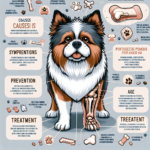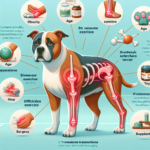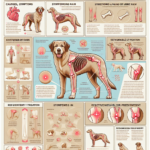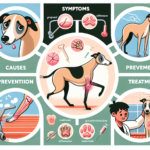Portuguese Podengo Pequeno Joint Pain: Causes, Symptoms, Prevention, and Treatment

Introduction
The Portuguese Podengo Pequeno is a small, lively breed known for its agility, intelligence, and hunting prowess. Originating from Portugal, this breed has a rich history dating back to ancient times, where it was primarily used for hunting small game such as rabbits. The Podengo Pequeno is the smallest of the three Podengo varieties, characterized by its wedge-shaped head, erect ears, and expressive eyes. Despite its small size, this breed is robust and energetic, making it a popular choice for active families and individuals.
Like many breeds, the Portuguese Podengo Pequeno is prone to certain health issues. While generally healthy, they can suffer from conditions such as patellar luxation, dental problems, and joint pain. Joint health is particularly crucial for this breed due to their active nature and the physical demands placed on their bodies.
Breed-Specific Joint Pain Risks
Genetic Predisposition
The Portuguese Podengo Pequeno, like many purebred dogs, can be genetically predisposed to joint-related issues. While not as commonly affected by hip dysplasia as larger breeds, they can still suffer from conditions such as patellar luxation and arthritis. Patellar luxation, where the kneecap dislocates from its normal position, is particularly prevalent in small breeds and can lead to significant discomfort and mobility issues.
Age-Related Risks
As the Portuguese Podengo Pequeno ages, the risk of developing joint pain increases. Arthritis is a common age-related condition that affects the joints, leading to inflammation, pain, and stiffness. Owners should be vigilant as their dogs reach middle age, typically around 7-8 years old, and monitor for any signs of joint discomfort.
Activity Level and Joint Stress
The Portuguese Podengo Pequeno is an active and agile breed, often participating in activities such as agility, hunting, and play. While their high energy levels are beneficial for their overall health, they can also contribute to joint stress. Repetitive motions, jumping, and running can place strain on their joints, potentially leading to wear and tear over time.
Common Symptoms of Joint Pain in Portuguese Podengo Pequeno
General Symptoms
- Limping or favoring one leg
- Stiffness, especially after rest or sleep
- Reluctance to jump, run, or climb stairs
- Decreased activity level or lethargy
- Swelling around the joints
- Whining or showing signs of discomfort when touched
Breed-Specific Symptoms
In the Portuguese Podengo Pequeno, symptoms of joint pain may manifest more subtly due to their stoic nature. Owners should pay close attention to any changes in their dog’s behavior, such as a decrease in their usual playful demeanor or reluctance to engage in activities they previously enjoyed. Additionally, watch for any signs of patellar luxation, such as a sudden skipping or hopping gait.
When to Consult a Vet
If you notice any of the above symptoms in your Portuguese Podengo Pequeno, it is essential to consult a veterinarian promptly. Early diagnosis and intervention can significantly improve the prognosis and quality of life for your dog. Persistent limping, noticeable pain, or any sudden changes in behavior should be addressed by a professional.
Preventive Measures for Joint Health
Exercise Recommendations
Regular exercise is crucial for maintaining joint health in the Portuguese Podengo Pequeno. However, it is essential to balance activity levels to avoid overexertion. Low-impact exercises such as walking, swimming, and controlled play are ideal. Avoid activities that involve excessive jumping or running on hard surfaces, as these can increase joint stress.
Dietary Suggestions
A balanced diet rich in essential nutrients can support joint health. Consider incorporating foods or supplements that contain glucosamine, chondroitin, and omega-3 fatty acids, which are known to promote joint health and reduce inflammation. Consult your veterinarian for specific dietary recommendations tailored to your dog’s needs.
Weight Management
Maintaining a healthy weight is vital for reducing joint stress in the Portuguese Podengo Pequeno. Excess weight can exacerbate joint pain and lead to further complications. Monitor your dog’s weight regularly and adjust their diet and exercise routine as needed to ensure they remain within a healthy weight range.
Early Screening and Monitoring
Regular veterinary check-ups are essential for early detection of joint issues. Your veterinarian may recommend specific screening tests, such as X-rays or joint fluid analysis, to assess your dog’s joint health. Early intervention can help manage and mitigate the progression of joint-related conditions.
Treatment Options for Joint Pain
Non-Surgical Treatments
For mild to moderate joint pain, non-surgical treatments can be highly effective. These may include:
- Medications: Nonsteroidal anti-inflammatory drugs (NSAIDs) can help reduce inflammation and alleviate pain. Your veterinarian may also prescribe pain relievers or joint supplements.
- Physical Therapy: Controlled exercises and physical therapy can improve joint mobility and strengthen the muscles around the joints.
- Lifestyle Adjustments: Modifying your dog’s activity levels and providing a comfortable living environment can help manage joint pain.
Surgical Options
In severe cases, surgical intervention may be necessary to alleviate joint pain. Common surgical options include:
- Patellar Luxation Surgery: This procedure realigns the kneecap to prevent dislocation and improve joint stability.
- Arthroscopy: A minimally invasive procedure used to diagnose and treat joint issues.
- Joint Replacement: In extreme cases, joint replacement surgery may be considered to restore mobility and reduce pain.
Alternative Therapies
Alternative therapies can complement traditional treatments and provide additional relief for joint pain. These may include:
- Acupuncture: This ancient practice involves inserting thin needles into specific points on the body to relieve pain and promote healing.
- Hydrotherapy: Water-based exercises can improve joint mobility and reduce pain without placing stress on the joints.
- Massage: Regular massage can help relax muscles, improve circulation, and alleviate joint pain.
Lifestyle and Management Tips
Daily Care Routine
A consistent daily care routine can help manage and alleviate joint pain in the Portuguese Podengo Pequeno. Consider the following:
- Provide regular, low-impact exercise to maintain joint mobility.
- Incorporate joint supplements into your dog’s diet as recommended by your veterinarian.
- Monitor your dog’s weight and adjust their diet and exercise routine as needed.
- Schedule regular veterinary check-ups to monitor joint health.
Modifying the Home Environment
Making your home more comfortable for a dog suffering from joint pain can significantly improve their quality of life. Consider the following modifications:
- Provide orthopedic beds to support your dog’s joints while they rest.
- Use ramps or steps to help your dog access furniture or climb stairs without jumping.
- Ensure that your dog’s living area is free of slippery surfaces to prevent falls and injuries.
Long-Term Management
Long-term management strategies are essential for keeping your Portuguese Podengo Pequeno active and happy despite joint pain. These may include:
- Continuing regular, low-impact exercise to maintain joint health.
- Providing a balanced diet with joint-supporting nutrients.
- Regularly consulting with your veterinarian to monitor and manage joint health.
- Incorporating alternative therapies such as acupuncture or hydrotherapy as needed.
FAQs About Portuguese Podengo Pequeno and Joint Pain
What are the early signs of joint pain in Portuguese Podengo Pequeno?
Early signs of joint pain in Portuguese Podengo Pequeno include limping, stiffness, reluctance to jump or climb stairs, and decreased activity levels. If you notice any of these symptoms, consult your veterinarian promptly.
Can joint pain in Portuguese Podengo Pequeno be prevented?
While it may not be possible to prevent joint pain entirely, you can take steps to reduce the risk. Regular exercise, a balanced diet, weight management, and early screening can all contribute to maintaining joint health.
Are there specific exercises that are beneficial for joint health in this breed?
Low-impact exercises such as walking, swimming, and controlled play are ideal for maintaining joint health in Portuguese Podengo Pequeno. Avoid activities that involve excessive jumping or running on hard surfaces.
What dietary supplements can support joint health in Portuguese Podengo Pequeno?
Supplements containing glucosamine, chondroitin, and omega-3 fatty acids can support joint health and reduce inflammation. Consult your veterinarian for specific recommendations tailored to your dog’s needs.
When should I consider surgical options for my dog’s joint pain?
Surgical options should be considered if non-surgical treatments are ineffective and your dog’s quality of life is significantly impacted by joint pain. Consult your veterinarian to discuss the best course of action for your dog’s specific condition.
Conclusion
Maintaining joint health in the Portuguese Podengo Pequeno is essential for ensuring their overall well-being and quality of life. By understanding the breed-specific risks, recognizing early symptoms, and implementing preventive measures, owners can help their dogs lead active and pain-free lives. Regular veterinary check-ups, a balanced diet, appropriate exercise, and early intervention are key to managing joint health effectively. Always consult your veterinarian for personalized advice and treatment options to keep your Portuguese Podengo Pequeno happy and healthy.




